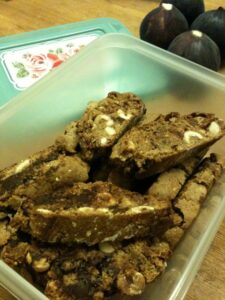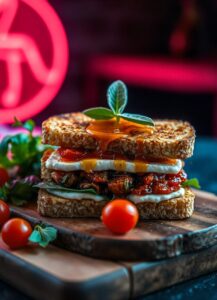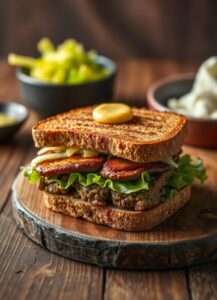Three Cheese, Porchetta, Pink Radicchio, Hazelnut & Truffle Honey Toastie
Last weekend I suggested B might like to make his own dinner. Knowing I was eating at home too, and he being not often prepared to miss out, the obvious question followed; ‘Why, what are YOU having?’.
His response, after assuring him he wouldn’t want it, was one I get often – ’Why can’t you blog stuff that will actually come up on a Google search?’.
He says this with mild contempt, as he doesn’t understand the concept of doing things ‘just because’. Just because I want to, because it’s fun, because I can. Because I’m not fussed about SEO or monetisation.
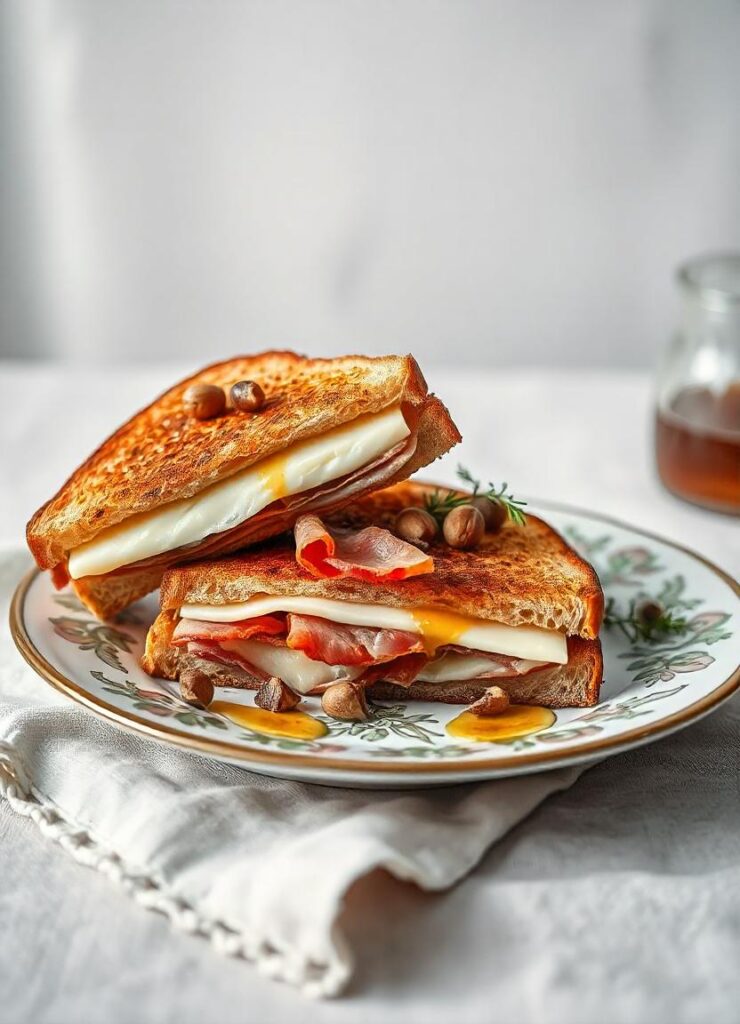
Add to this the fact that I HATE being told what to do. I SHALL eat weird combos if I want to. sticks bottom lip out
The idea for this was formed during and after a leisurely wander along Bellenden Road, as I’m wont to do after a weekend morning’s gym session, and find myself in the uber middle class shopping den of General Store.
As usual, all sensibilities go out the window as I purchase random ingredients in no rhythm or order than that of prettiness and impulse. In hindsight they’re also ingredients that hint at a snifter of that Spring in the air that I grasp to my chest with culinary intentions.
I’m not a remotely girly girl, in most situations, but who can resist the pink kissed frilly hem of pink radicchio, soft focus bloom of the vegetable world, that pairs so well with slender slivers of marbled porchetta that lilt a similarly hued tune.
You might also: Pao de Queijo and the Beauty of Breakfast Abroad
I want a toastie. A toastie needs cheese. This one, I feel will benefit with a combination. A smear of goats curd shouts ‘hazelnuts’, so these also go in, lightly toasted and smashed. But it also needs melty cheese for full on, molten toastie effect.
I’d brought a wheel of cheese back from my trip to Brazil. Typical of the region of Minas Gerais, where local cheese is as ubiquitous as dulce de leche. Often served together no less. They have two common varieties; a pale, firm, fresh and unsalty number and then this. I visited the farm where they produce this particular one, named simply ‘Araxa Quesa’ – cheese of the region it’s exclusive to; just 9 cities within the region of Minas own the PDO. This award winning farm’s 56 cows (including a number of Jersey’s I notice with astonishment, standing out with those doleful eyes and lengthy lashes against the local ones that look to me to be indian with their drooping ears and slender physique, though I’m told they’re both a fairly common thing here) are milked twice a day with all production going to make cheese. The unpasteurised cheese is sold at different stages of ageing, the locals preferring it pale and milky but it’s aged much longer and also exported nationally (mine has got a proper funk going on, but I’m told to keep it out of the fridge to let it develop naturally). It’s affectionately known as ‘drop cheese’ due to it’s dripping process, it’s then stored, rotated and washed regularly. It’s delicious eaten in slices with their coffee, taken black and sweet, served in glasses and always made in batches then kept in a thermos for whenever required. Eaten for breakfast, snacking and post meals, the Brazilians of Minas like cheese. A lot. Even their butter tastes and smells like cheese.
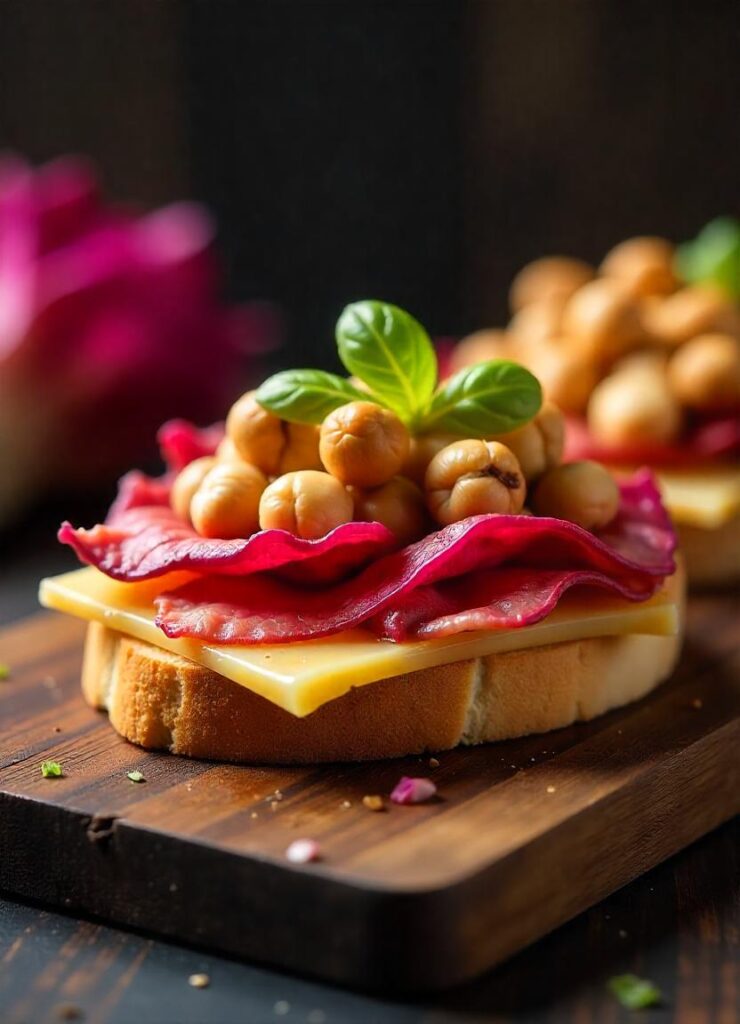
ANYWAY. I figured it would make a great addition to my cheese mixture, and a pungency to add structure to what was, so far – sweetly bitter radicchio, sweet and fatty porchetta, nutty hazelnuts and creamy curd. I finish this combo off with more sweet and nutty in the form of comte and then a drizzle of truffle honey.
Did I mention that the bread I used is made by Little Bread Pedlar? They make the best pastries I’ve tried in London and their sourdough ain’t too shabby either, it looks like they’re stocking it regularly at General Store too. Good bread times for SE as Brickhouse opens shortly with their own cafe, using Square Mile coffee too no less.
I give you – The Pink Toastie – pure unbridled romance. If you’re into that sort of thing
Construction tips
Butter outside sides of the bread liberally – I usually do the insides too (and ALWAYS match the slices up so they don’t sit back to front – yeah, OCD)
Spread the bottom, inside, layer with goats curd and scatter over toasted hazelnuts, lay over crisp leaves of pink radicchio, then thin slices of porchetta or other fatty ham. Finally add handfuls of the other two cheeses, grated and mixed together. Always much, much more than you think is decent.
Place in a sandwich or panini press and leave for much longer than you think it needs. The cheese should fully melt, pool around the base of the sandwich and then crisp up again for optimal sandwich crust.
If you don’t have a sandwich press, a similar effect can be achieved by placing the sandwich in a heavy based frying pan with a weighted plate on top, then flip half way through so both sides toast.
As a sub for the minas cheese, I’d probably use something of a washed rind but firm.
You might also like: Gypsy Tart with Cachaça Lime Curd
I’ve barely touched the cachaca I brought home from Brazil, in fact most went out as gifts, mainly because I simply couldn’t imagine it tasting the way I’d developed such a taste for, made here in the deep murkiness of London as it makes it’s final push to emerge from the grips of Winter. But, believe me, we encountered plenty of it whilst out there, at least one caipirinha a night was the rule. Not a bad one to live by to be honest. Of course it’s made from fermented sugar cane juice, which I tried on the side of the road, squeezed fresh and simply directly from the cane – the ultimate in thirst quenching sugary treats.
Back home, as another kick up the backside to Spring, I made a twist on the classic by subbing lime for floral bergamot – pure sunshine in a glass.
Muddle 1 quarter of a bergamot, chopped into wedges with 1 tablespoon golden sugar (I’d LOVE to try this with raw cane sugar) then shake with plenty of cracked ice and 60ml good quality cachaça and serve.
Try it!
I gathered many and varied versions of the sugar cane spirit across the regions I travelled, caipirinhas should be made with the clear or silver variety rather than the barrel aged sipping ones. I need to investigate the brands over here…




